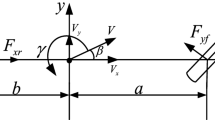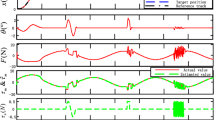Abstract
This study proposes a method for operating wheeled cross-coupled systems. Wheeled cross-coupled systems are more sensitive to disturbances than other cross-coupled systems. When the slip phenomenon occurs in wheels, it causes synchronous errors between axles, resulting in differences in the controller outputs of the two axles. In the worst case, the two axles can end up competing. To solve this problem, this study introduces base controllers to each axle using a discrete-time variable structure control system with a decoupled disturbance compensator and an auxiliary controller, called a synchronous error compensator (SEC), to minimize synchronous errors arising from differences in the states of the two axles. Experiments are conducted on a verification system with a similar form of overhead hoist transfer (OHT) to demonstrate the effectiveness of the proposed method. Results reveal that the SEC generates control commands to make the control inputs (current command) and state variables (velocity feedback) of the two axles similar.
Similar content being viewed by others
References
Y. Koren, “Cross-coupled biaxial computer control for manufacturing systems,” Journal of Dynamic Systems, Measurement, and Control (JDSMC), vol. 102, no. 4, pp. 265–272, 1980.
K. K. Tan, S. Y. Lim, S. Huang, H. F. Dou, and T. S. Giam, “Coordinated motion control of moving gantry stages for precision applications based on an observer-augmented composite controller,” IEEE Transactions on Control Systems Technology, vol. 12, no. 6, pp. 984–991, 2004.
M. Naumovic and M. Stojic, “Design of the observer-based cross-coupled positioning servodrives,” Proc. of the IEEE International Symposium on Industrial Electronics (ISIE’ 97), vol. 2, no. 6, pp. 643–648, 1997.
M. Naumovic, “Cross-coupled motion controller for two cooperating robot arms,” Proc. of the IEEE International Symposium on Industrial Electronics (ISIE’ 99), vol. 2, pp. 909–913, 1999.
L. Feng, Y. Koren, and J. Borenstein, “Cross-coupling motion controller for mobile robots,” IEEE Control Systems Magazine, vol. 13, no. 6, pp. 35–43, 1993.
B. Chu, S. Kim, D. Hong, H.-K. Park, and J. Park, “Optimal cross-coupled synchronizing control of dual-drive gantry system for a SMD assembly machine,” JSME International Journal Series C Mechanical Systems, Machine Elements and Manufacturing, vol. 47, no. 3, pp. 939–945, 2004.
P. Li, G. Zhu, B. He, and X. Zeng, “Synchronization control for dual-drive system of gantry-type machine tools based on extended state observer,” Proc. of IEEE/ASME International Conference on Advanced Intelligent Mechatronics (AIM), pp. 1299–1304, 2018.
D. Sun, X. Shao, and G. Feng, “A model-free cross-coupled control for position synchronization of multi-axis motions: Theory and experiments,” IEEE Transactions on Control Systems Technology, vol. 15, no. 2, pp. 306–314, 2007.
Y. T. Shih, C. S. Chen, and A. C. Lee, “A novel cross-coupling control design for bi-axis motion,” International Journal of Machine Tools and Manufacture, vol. 42, no. 14, pp. 1539–1548, 2002.
J. Yang and Z. Li, “A novel contour error estimation for position loop-based cross-coupled control,” IEEE/ASME Transactions on Mechatronics, vol. 16, no. 4, pp. 643–655, 2011.
K. Ishizaki, B. Sencer, and E. Shamoto, “Cross coupling controller for accurate motion synchronization of dual servo systems,” International Journal of Automation Technology, vol. 7, no. 5, pp. 514–522, 2013.
S.-S. Yeh and P.-L. Hsu, “Estimation of the contouring error vector for the cross-coupled control design,” IEEE/ASME Transactions on Mechatronics, vol. 7, no. 1, pp. 44–51, 2002.
F. Huo and A. Poo, “Improving contouring accuracy by using generalized cross-coupled control,” International Journal of Machine Tools and Manufacture, vol. 63, pp. 49–57, 2012.
Z. Liu, W. Lin, X. Yu, J. J. Rodríguez-Andina, and H. Gao, “Approximation-free robust synchronization control for dual-linear-motors-driven systems with uncertainties and disturbances,” IEEE Transactions on Industrial Electronics, vol. 69, no. 10, pp. 10500–10509, October 2022.
J. He, J. Ding, C. Zhang, S. Mao, J. Liu, J. Hu, and Z. Ma, “Research on Multi-axis Servo Synergic Control System Based on Sliding Mode Variable Structure,” Proc. of IECON 2019 - 45th Annual Conference of the IEEE Industrial Electronics Society, pp. 6908–6915, 2019.
C. Dongnan, “Cross-coupled synchronization control for dual driven scanning system sliding mode-based,” Proc. of the 27th Chinese Control and Decision Conference, pp. 760–765, 2015.
Z. Kuang, H. Gao, and M. Tomizuka, “Precise linear-motor synchronization control via cross-coupled second-order discrete-time fractional-order sliding mode,” IEEE/ASME Transactions on Mechatronics, vol. 26, no. 1, pp. 358–368, February 2021.
G. Zhong, H. Yi, and W. Dou, “Design of dual-drive vertical lift servo system and synchronous control performance analysis,” IEEE/ASME Transactions on Mechatronics, vol. 25, no. 6, pp. 2927–2937, December 2020.
W. Chen, Y. Wu, R. Du, Q. Chen, and X. Wu, “Speed tracking and synchronization of a dual-motor system via second order sliding mode control,” Mathematical Problems in Engineering, vol. 2013, 919837, 2013.
L. Li, L. Sun, S. Zhang, and Q. Yang, “Speed tracking and synchronization of multiple motors using ring coupling control and adaptive sliding mode control,” ISA Transactions, vol. 58, pp. 635–649, 2015.
C. Zhu, Q. Tu, C. Jiang, M. Pan, and H. Huang, “A cross coupling control strategy for dual-motor speed synchronous system based on second order global fast terminal sliding mode control,” IEEE Access, vol. 8, pp. 217967–217976. 2020.
T. Zeng, X. Ren, and Y. Zhang, “Fixed-time sliding mode control and high-gain nonlinearity compensation for dualmotor driving system,” IEEE Transactions on Industrial Informatics, vol. 16, no. 6, pp. 4090–4098, 2020.
H. Lu, W. Fan, and Y. Zhang, “Cross-coupled fuzzy logic sliding mode control of dual-driving feed system,” Advances in Mechanical Engineering, vol. 10, no. 2, pp. 1–17, 2018.
K. L. Barton and A. G. Alleyne, “A cross-coupled iterative learning control design for precision motion control,” IEEE Transactions on Control Systems Technology, vol. 16, no. 6, pp. 1218–1231, 2008.
F.-J. Lin, P.-H. Chou, C.-S. Chen, and Y.-S. Lin, “DSP-based cross-coupled synchronous control for dual linear motors via intelligent complementary sliding mode control,” IEEE Transactions on Industrial Electronics, vol. 59, no. 2, pp. 1061–1073, 2012.
P. N. Dao and Y.-C. Liu, “Adaptive reinforcement learning strategy with sliding mode control for unknown and disturbed wheeled inverted pendulum,” International Journal of Control, Automation, and Systems, vol. 19, pp. 1139–1150, 2020.
N. G. Ulu, E. Ulu, and M. Cakmakci, “Design and analysis of a modular learning based cross-coupled control algorithm for multi-axis precision positioning systems,” International Journal of Control, Automation, and Systems, vol. 14, pp. 272–281, 2016.
B. Wang, M. Iwasaki, and J. Yu, “Command filtered adaptive backstepping control for dual-motor servo systems with torque disturbance and uncertainties,” IEEE Transactions on Industrial Electronics, vol. 69, no. 2, pp. 1773–1781, 2022.
C. Li, B. Yao, and Q. Wang, “Modeling and synchronization control of a dual drive industrial gantry stage,” IEEE/ASME Transactions on Mechatronics, vol. 23, no. 6, pp. 2940–2951, 2018.
P. Shi, W. Sun, X. Yang, I. J. Rudas, and H. Gao, “Master-slave synchronous control of dual-drive gantry stage with cogging force compensation,” IEEE Transactions on Systems, Man, and Cybernetics: Systems, vol. 53, no. 1, pp. 216–225, 2023.
H. Bilal, B. Yin, M. S. Aslam, Z. Anjum, A. Rohra, and Y. Wang, “A practical study of active disturbance rejection control for rotary flexible joint robot manipulator,” Soft Computing, vol. 27, no. 8, pp. 4987–5001, 2023.
W. Gao, Y. Wang, and A. Homaifa, “Discrete-time variable structure control systems,” IEEE Transactions on Industrial Electronics, vol. 42, no. 2, pp. 117–122, 1995.
Y. Eun, J.-H. Kim, K. Kim, and D.-I. Cho, “Discrete-time variable structure controller with a decoupled disturbance compensator and its application to a CNC servomechanism,” IEEE Transactions on Control Systems Technology, vol. 7, no. 4, pp. 414–423, 1999.
J.-S. Han, T.-I. Kim, T.-H. Oh, S.-H. Lee, and D.-I. Cho, “Effective disturbance compensation method under control saturation in discrete-time sliding mode control,” IEEE Transactions on Industrial Electronics, vol. 67, no. 7, pp. 5696–5707, 2020.
D.-I. Cho and J. K. Hedrick, “Automotive powertrain modeling for control,” Journal of Dynamic Systems, Measurement, and Control (JDSMC), vol. 111, no. 4, pp. 568–576, 1989.
E. Bakker, L. Nyborg, and HB. Pacejka, “Tyre modeling for use in vehicle dynamics studies,” SAE Transactions, vol. 96, no. 2, pp. 190–204, 1987.
W. Bahn, S. H. Lee, S. S. Lee, and D.-I. Cho, “Control of 400 watt belt-drive and 400 watt ball-screw servo systems using discrete-time variable structure control,” Proc. of the 19th World Congress of the International Federation of Automatic Control, vol. 19, no. 1, pp. 8378–8383, 2014.
J.-S. Han, W. Bahn, T.-I. Kim, J.-H. Park, S.-S. Lee, S.-H. Lee, and D.-I. Cho, “Decoupled disturbance compensation under control saturation with discrete-time variable structure control method in industrial servo systems,” Proc. of 16th International Conference on Control, Automation and Systems (ICCAS), pp. 1453–1457, 2016.
J.-S. Han, T.-H. Oh, Y.-S. Kim, H.-T. Lim, D.-Y. Yang, S.-H. Lee, and D.-I. Cho, “Performance optimization methodology for discrete-time sliding mode control in industrial servo systems under control input saturation and disturbance,” IFAC-PapersOnLine, vol. 53, no.2, pp. 9112–9117, 2020.
Author information
Authors and Affiliations
Corresponding author
Ethics declarations
The authors declare that there is no competing financial interest or personal relationship that could have appeared to influence the work reported in this paper.
Additional information
Publisher’s Note Springer Nature remains neutral with regard to jurisdictional claims in published maps and institutional affiliations.
This work was supported by the MSIT(Ministry of Science and ICT), Korea, under the Grand Information Technology Research Center support program (IITP-2023-2020-0-01741) supervised by the IITP(Institute for Information & communications Technology Planning & Evaluation) and the Technology development Program(RS-2023-00266705) funded by the Ministry of SMEs and Startups(MSS, Korea).
Yeon-Beom Choi received his B.S. and M.S. degrees in electrical engineering from Tech University of Korea, in 2013 and 2016, respectively. He is currently working toward a Ph.D. degree with the Information and Communications, Tech University of Korea. Also, He is currently a servo drive engineer with RS Automation Company, Ltd., Korea. His research interests include nonlinear control theory to servo drive.
Sang-Hoon Lee received his B.S., M.S., and Ph.D. degrees in electrical and computer engineering from Seoul National University, Seoul, Korea in 1991, 1993, and 1997, respectively. He is currently a Research and Development Center Manager with RS Automation Company, Ltd., Korea. His research interests include nonlinear control theory, and its application to electric machines and factory automation.
Doo-Hee Jung received his B.S., M.S., and Ph.D. degrees in electrical and computer engineering from Seoul National University, in 1991, 1993, and 1998, respectively. His research interests include nonlinear control and embedded systems for various industrial applications.
Rights and permissions
About this article
Cite this article
Choi, YB., Lee, SH. & Jung, DH. Controller Design Based on a Synchronous Error Compensator for Wheeled Cross-coupled Systems. Int. J. Control Autom. Syst. 22, 1728–1738 (2024). https://doi.org/10.1007/s12555-023-0687-x
Received:
Revised:
Accepted:
Published:
Issue Date:
DOI: https://doi.org/10.1007/s12555-023-0687-x




